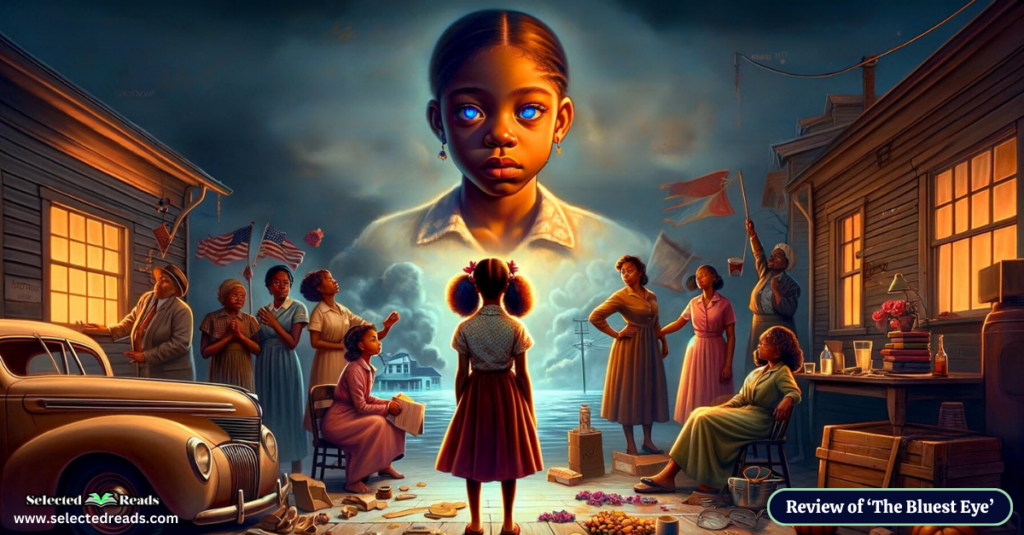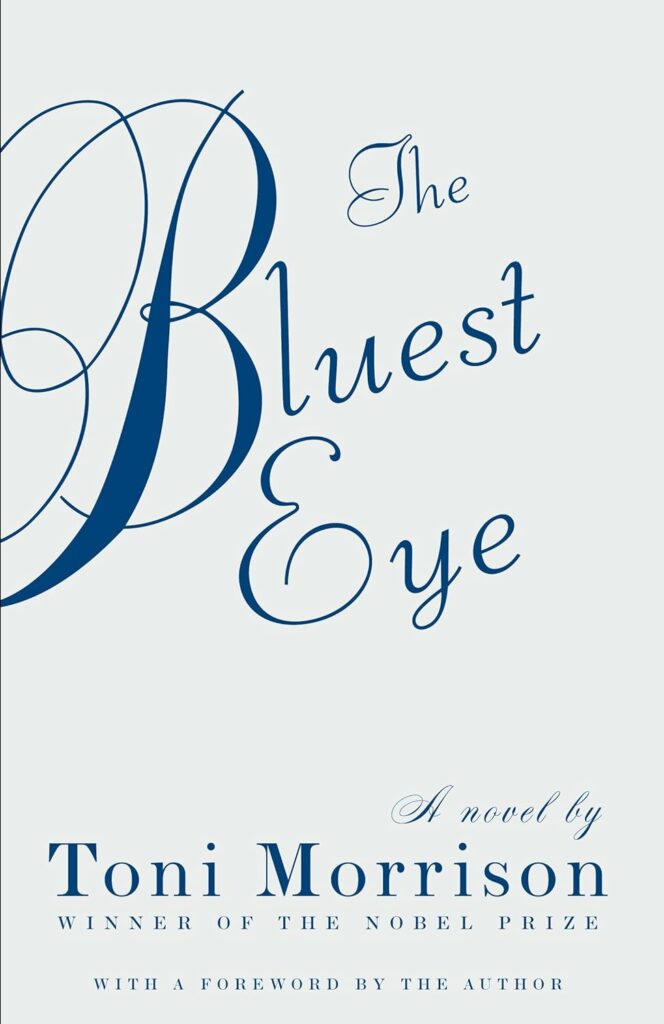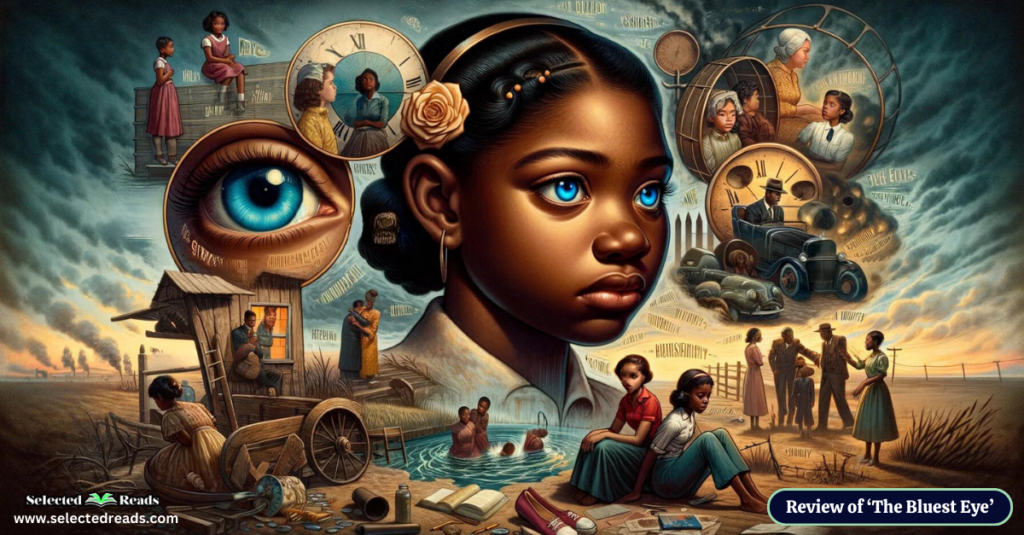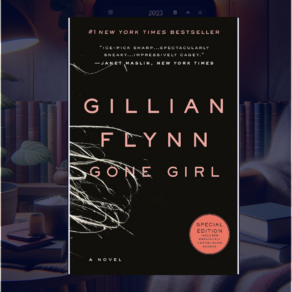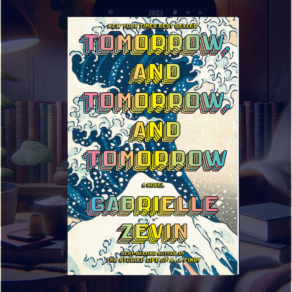In today’s post I will take you into the world of Toni Morrison with this short review of her seminal work, “The Bluest Eye.” Published in 1970, the novel remains a powerful and poignant commentary on beauty, identity, and the devastating impact of racism. Through an extended summary, we’ll uncover the layers of Morrison’s narrative, focusing on the tragic quest of Pecola Breedlove, an eleven-year-old African American girl who dreams of having blue eyes, believing it to be the key to acceptance and love in a world that dismisses her.
As we dissect the characters populating this narrative landscape, we’ll gain insight into the complex dynamics at play within the Breedlove family and the broader community of Lorain, Ohio. Furthermore, to enrich the discussion and foster deeper understanding, we will provide a set of book club questions designed to prompt reflection and debate.
These questions will encourage readers to consider the novel’s critique of societal beauty standards, the impact of racism and class, the significance of family and community, and the poignant use of narrative structure and symbolism by Morrison.
Related: The Souls of Black Folk Summary
The Bluest Eye Summary
Toni Morrison’s “The Bluest Eye,” marks an extraordinary debut, weaving a narrative that is both poignant and profound in its exploration of beauty, identity, and the scars left by racism. At its core, this novel presents the tragic life of Pecola Breedlove, a young African American girl growing up in Lorain, Ohio, in the years following the Great Depression.
Morrison sets the stage for a society where the Eurocentric standards of beauty – blond hair and blue eyes – are not just preferred but seen as the epitome of beauty, deeply affecting the self-esteem and identity of those who do not fit this mold.
Pecola’s character is heartbreakingly vivid; she is an 11-year-old who internalizes the racial prejudices of her time, equating beauty with whiteness. Her deepest desire is to have blue eyes, believing that this physical transformation will alter her life for the better, ushering in acceptance, love, and happiness that seem so out of reach in her current state. This yearning is not just a whimsical wish for physical beauty but a desperate plea for visibility, belonging, and a drastic change from her reality of neglect, abuse, and racial discrimination.
The novel frames Pecola’s story within the broader context of her community and family. Through characters like Claudia and Frieda, two sisters from a relatively stable household who serve as counterpoints to Pecola, Morrison explores themes of sisterhood, community, and the varying impacts of racism. The Breedlove family itself, with its internalized racism and cyclical poverty, serves as a microcosm for examining the broader African American experience of the time.
Photo: Amazon
Morrison’s prose is lyrical and evocative, described by The New York Times as akin to poetry, both for its beauty and its ability to convey deep pain and wonder. The narrative structure, which includes multiple perspectives and a non-linear timeline, allows Morrison to delve deeply into the psychology of her characters, revealing the complex interplay between individual trauma and societal pressures.
Besides challenging the notion of beauty, “The Bluest Eye” forces readers to confront the devastating effects of racism, the longing for acceptance, and the tragic consequences of unfulfilled dreams. It’s a powerful examination of how societal norms and racial prejudices can warp the self-perception and destinies of individuals and communities. Morrison poses difficult questions about race, class, and gender, offering no easy answers but providing a profound commentary on the American social fabric.
Related: Beloved Toni Morrison Summary
The Bluest Eye Characters
“The Bluest Eye” by Toni Morrison is rich with complex characters, each offering a unique perspective on the novel’s central themes of beauty, identity, and the impact of racism. Here’s a quick overview of some of the key characters:
- Pecola Breedlove: The protagonist, an eleven-year-old African American girl who believes that possessing blue eyes would make her beautiful and loved, transforming her harsh reality. Pecola’s life is marked by a deep sense of unworthiness and invisibility, stemming from societal and familial rejection.
- Claudia MacTeer: The narrator of much of the novel, Claudia represents a more resilient response to the oppressive beauty standards and racism of the era. Unlike Pecola, Claudia resists idolizing white beauty standards, often questioning and rebelling against them. Through Claudia’s eyes, readers witness the tragic downfall of Pecola, offering insights into the complexities of race, family, and community.
- Frieda MacTeer: Claudia’s older sister, who shares many of Claudia’s insights and rebellions but also provides a slightly more mature perspective on the events unfolding around them. Frieda and Claudia’s relationship offers a counter-narrative to Pecola’s isolation, showcasing a supportive and loving family environment.
- Cholly Breedlove: Pecola’s father, whose life has been marked by abandonment, humiliation, and abuse. Cholly’s complex character is tragic in its own right, embodying the destructive power of racism and personal despair. His actions in the novel are reprehensible, yet Morrison provides a background that complicates the reader’s response to him.
- Pauline (Polly) Breedlove: Pecola’s mother, who also internalizes the racial prejudices of the time, longing for the white world’s acceptance and beauty standards. Pauline’s dissatisfaction with her life and appearance directly impacts her relationship with her family, especially Pecola, whom she often neglects.
- Sammy Breedlove: Pecola’s brother, who, like the rest of his family, faces personal demons and struggles. His presence in the novel adds depth to the Breedlove family dynamics, though his character is less focused on than others.
- Mrs. MacTeer: The mother of Claudia and Frieda, representing a strong, caring figure who contrasts sharply with Pauline Breedlove. Her warmth and protective nature provide a nurturing environment for her daughters and, at times, Pecola.
- Soaphead Church: A self-proclaimed psychic and spiritual advisor in the community, who plays a pivotal role in Pecola’s quest for blue eyes. His character is controversial and morally ambiguous, reflecting the novel’s themes of deception, self-delusion, and the exploitation of innocence.
The Bluest Eye Book Club Questions
Here are some questions that could spark engaging discussions:
- Exploration of Beauty Standards: How does Morrison critique the beauty standards of the time, and how do these standards affect the characters’ perceptions of themselves and others? Discuss how the desire for blue eyes symbolizes a deeper yearning within Pecola and the community.
- Impact of Racism and Class: In what ways do racism and class influence the characters’ lives and destinies in “The Bluest Eye”? Consider how different characters respond to and are shaped by these forces.
- Family Dynamics and Influence: How do the family environments of Pecola and the MacTeer sisters differ, and what impact do these differences have on their development and outlook on life? Discuss the significance of these contrasting family dynamics.
- Role of Community and Society: Consider the role of the larger community in Lorain, Ohio. How does the community contribute to or mitigate the struggles faced by the main characters? Discuss examples of support or neglect from the community and their implications.
- Narrative Structure and Voice: How does Morrison’s use of different perspectives and the non-linear narrative structure affect your understanding and engagement with the story? Discuss the impact of having Claudia as the primary narrator for much of the novel.
- Symbolism and Motifs: Identify and discuss the symbolism of key motifs in the novel, such as marigolds, dolls, and candy. How do these symbols contribute to the themes of beauty, innocence, and loss?
- The Role of Nature and Setting: How does Morrison use the setting and elements of nature (e.g., seasons, landscapes) to reflect the internal states of her characters or the dynamics of the community?
- Character Complexity: Choose a character you found particularly compelling or problematic. Discuss how Morrison develops this character and what they represent within the novel’s broader themes.
- Psychological and Emotional Impact: Discuss the psychological and emotional impact of the novel on you as a reader. Which moments or themes resonated most strongly with you, and why?
- Morrison’s Legacy and Relevance: Considering the novel was published over 50 years ago, discuss its relevance today. How do the themes of beauty, race, and identity explored in “The Bluest Eye” resonate with contemporary societal issues?
Related:
Final thoughts
In wrapping up our discussion of Toni Morrison’s seminal work, “The Bluest Eye,” we’ve ventured deep into the heart of its narrative, characters, and the profoundly resonant themes Morrison weaves throughout. The novel remains a powerful examination of the human condition, offering insights that are as relevant today as they were at the time of its publication. It challenges us to look beyond the surface, to question prevailing narratives of beauty and worth, and to recognize the profound effects of racism and exclusion.



